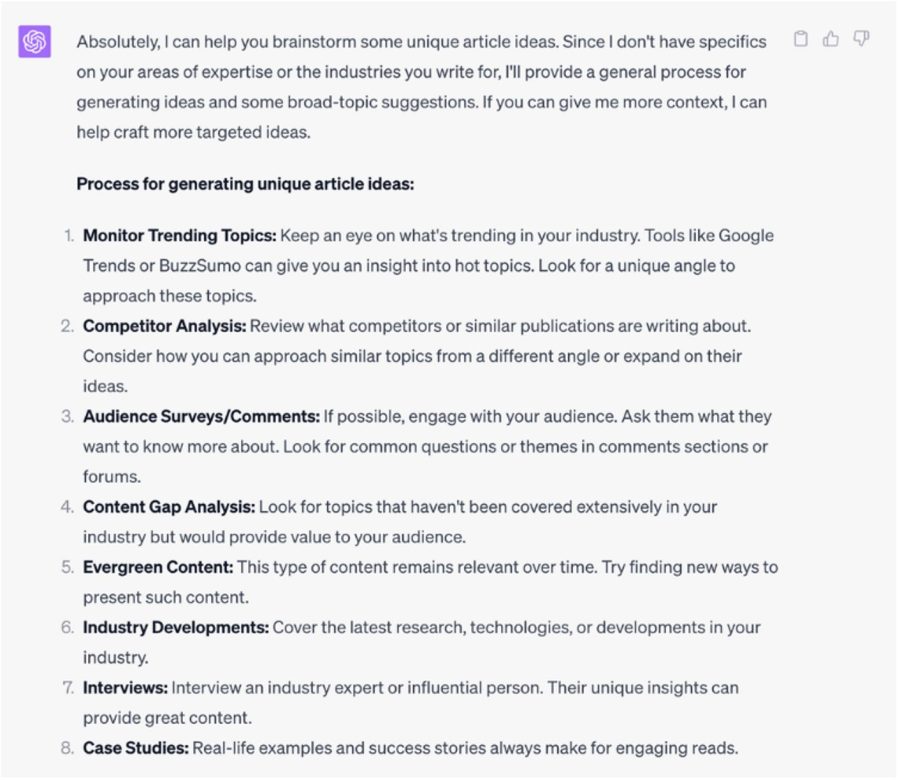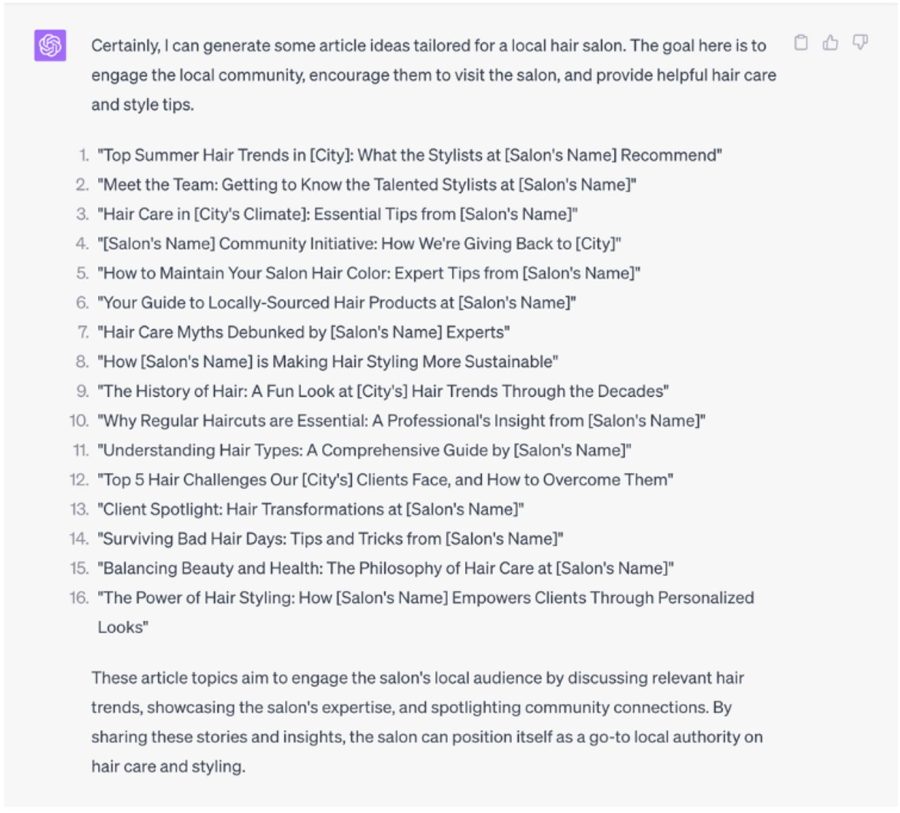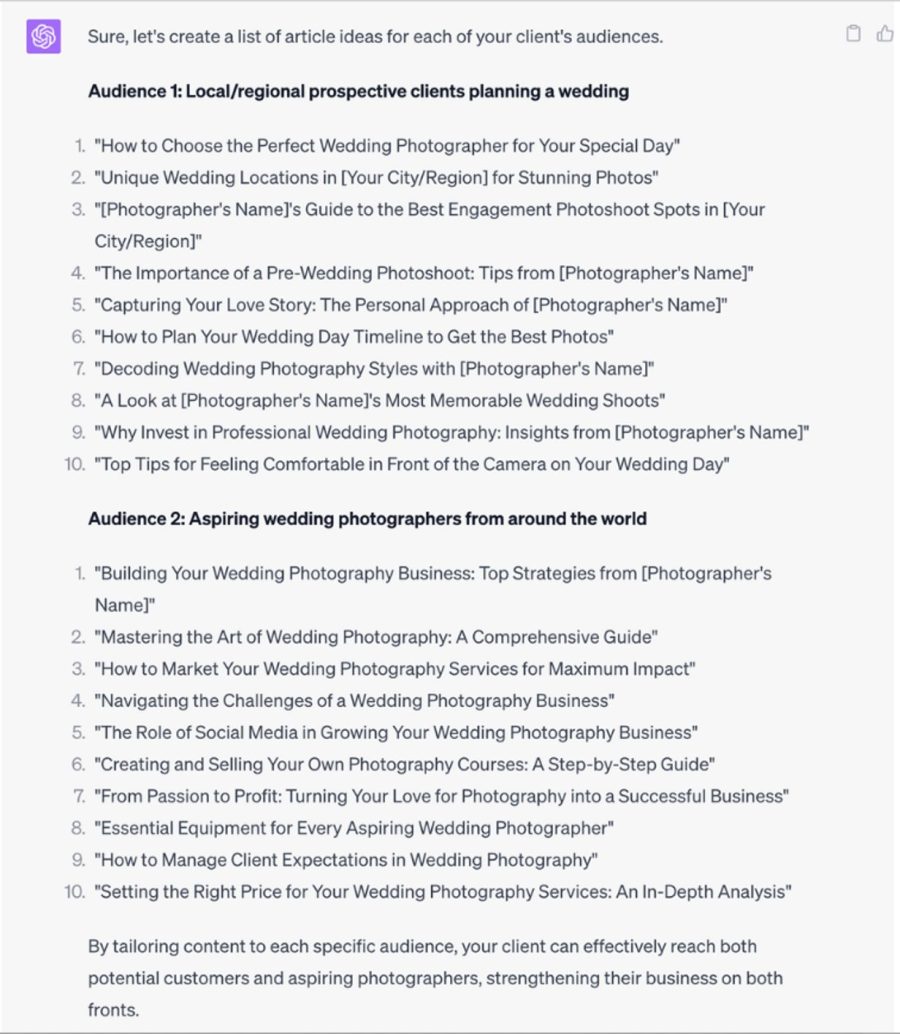Coming up with new ideas can be challenging. Recently I wrote an article for Digital Copywriter about different places to find potential article topics for your clients or potential clients.
But imagine having an assistant who works around the clock, offers a limitless wellspring of ideas, and never tires.
That’s where AI, specifically ChatGPT, comes into the picture.
Even if you don’t want to use AI to do any of your actual writing, you can still use it to help generate new ideas or get fresh perspectives for articles or blog posts.
Let’s take a look at how that would work.
What Is ChatGPT?
There are a lot of misconceptions about ChatGPT and large language models, in general.
Let’s start with a definition, and who better to explain ChatGPT than ChatGPT itself?
Here’s what I asked it…

And here was ChatGPT’s response…

So, ChatGPT works by predicting the likeliest words for a subject based on what it has “learned” about the topic. I like how ChatGPT compared it to learning a new language.
It’s comparable to how AWAI advises us to “learn” copywriting by copying the sales letters written by the masters. The more time you spend immersed in the works of the “greats,” the more you begin to recognize the patterns and rules that make up good copywriting practices.
ChatGPT also reminded me that it hasn’t been trained on new data since September 2021. And it advised me to fact-check the output. These are important points to remember.
How to Use ChatGPT for Ideas
Where should you start, if you want to use ChatGPT for brainstorming ideas?
The first thing I did was ask ChatGPT how it could help me think of topics to pitch to clients.

Here is ChatGPT’s response…


First, you’ll notice it told me up front that the suggestions would be generic without additional context.
But then, it gave me some ideas for finding topics on my own. A couple of them I mentioned in the previous article I wrote.
I really liked ChatGPT’s idea of interviewing experts. Granted, it’s not a new idea — copywriters interview people all the time.
But this is an example of how ChatGPT can help you, even if the ideas aren’t novel. Sometimes you just need a nudge in the right direction. “Oh yeah, why didn’t I think of that?”
But we know ChatGPT does better with more detailed information. So, let’s get a little more specific with our request.

Here’s how ChatGPT responded…

I thought these were 16 good ideas. Some of them might not be relevant to the client — maybe this salon doesn’t have a community initiative — but most of them can be tweaked to fit your client’s situation. And then, you have a trimester’s worth of content, if you follow a once-a-week publishing schedule.
And some ideas, like “Top Summer Hair Trends in [City],” could be customized to each season of the year.
Let’s try another prompt for a B2B business.
Here’s what I asked ChatGPT…

ChatGPT’s response:

I’ll be honest — I’m not sure how good these responses are, because I have no idea how manufacturer buyers do their buying research.
And this was a weak prompt. The better your prompts, the better output you’ll get from ChatGPT.
I told ChatGPT I didn’t know if my idea was realistic. But even with that limitation, it could still figure out what I wanted.
Let’s try another pretend client situation. Here’s what I asked ChatGPT…

And here was the response…

It gave me a list of possible topics for each audience. All of which, at first glance, sound like great ideas. At the least, they all contain the seed for a great idea. And the topics are relevant to each audience.
Getting the Best Results
As mentioned before, ChatGPT gives you the best output when you input good information. So, I asked ChatGPT what kinds of information it needs to provide you with the best results.

Here’s what ChatGPT advised…

The more information you give ChatGPT, the better it can help you.
Next, I thought it would be fun to ask ChatGPT what you should do if you’re new and don’t know what kinds of ideas to pitch to your client.

Here are its suggestions…

Finally, I asked ChatGPT what it would like to say to you about using it to brainstorm topics for blog posts or articles.

Here’s what ChatGPT had to say…

I have to say, I appreciate ChatGPT’s 24/7 availability.
I have an accountability partner, and I’m part of a mastermind group that’s very supportive and helpful.
But those people aren’t necessarily on my timetable. ChatGPT is around whenever I need it, whether that’s 3:00 in the afternoon or 3:00 in the morning.
Final Thoughts on Using ChatGPT for Ideas
I have to say, this post is probably the most fun I’ve ever had writing. I can’t even call it work. It was just a back-and-forth “conversation” with ChatGPT.
Whether you’re staring at a blank screen or looking for a fresh twist on a topic, AI can make the process smoother.
Even if you don’t want to use AI for your writing, it can still be a valuable tool in your creative process.
The goal is to leverage technology to make your tasks easier and your workflow smoother, freeing up more of your time and mental energy for the human aspect of creativity, which remains at the heart of all compelling writing.
At the end of the day, it’s your human touch — your intuition, experiences, empathy, and unique perspective — that breathes life into the words and connects with readers on a deeper level.
Here’s to embracing AI’s possibilities and the incredible, inspiring, and engaging content you’ll continue to craft.

